MV Valentina. Sea of Cortez, Baja, MexicoContents of this Issue: Dive Into Ambon; Maluku Resort & Spa, Indonesia Eight-Hour Ordeal for Shark Attack Victim, Craig DeWit You’d Better Have Blank Pages in that Passport MV Valentina. Sea of Cortez, Baja, Mexico Swimming with La Paz Whale Sharks Wes Skiles Verdict Unlucky for Some In-Water Recompression? Our Readers React Sri Lanka Aggressor Postscript Big Sharks Spotted Off Florida’s Atlantic Coast Can Dolphins Save Vaquita Porpoises from Extinction? That Devil Gas Is Not So Dangerous! Coming Soon: Texting While Diving Editorial Office: Ben Davison Publisher and Editor Undercurrent 3020 Bridgeway, Suite 102 Sausalito, CA 94965 sea lion diving on a luxury liveaboard from the February, 2017 issue of Undercurrent
In years past, I've dived and become familiar with the islands and dive sites north of La Paz in the Sea of Cortez, so when a local dive club booked a week on the MV Valentina, I jumped at the chance to join them. Early on, I had hints that this would be a different quality of liveaboard. The vessel is bigger than most, at 131 feet. Built as an open ocean trawler in the '80s, it has been remodeled at least three times: first, as a boutique cruise ship, then as the short-lived Baja Aggressor, and now as the Valentina, run by Fun Baja, a Mexican eco-tourism and dive operation, in cooperation with Azul Fleet, a Japanese liveaboard company. I expected this to be a delightful combination of local Mexican divemasters and ecotourism, with Japanese-financed attention to details, and that is was.
We began in La Paz and headed about 100 miles north, diving along the way, ultimately reaching Las Animas, small rocky islets that are habitat for sea lions and huge schools of fish. Here, schools of bigeye scad and surgeonfish swarmed us. I swam into large schools of Mexican barracuda, and as long as I moved slowly and managed my exhaust bubbles, they paid little attention. Schools of jacks, swirled about, as an occasional skipjack or wahoo passed, and Moorish idols, long-nosed hawkfish and endless blennies populated the boulders and minimal coral. I was delighted to watch several free-ranging octopus forage in the daylight. We did all our diving from three RIBs, back-rolling in and climbing out on the short ladders. We divided our 20 divers into three groups, each with a divemaster, the third being Carlos, another experienced local. While the crew would load divers' gear into the RIB and help then buckle up after they climbed down and sat on the gunwale, most of them preferred the macho route: gearing up at their filling station, then crossing the deck and stepping into the RIBs, with assistance. The RIBs are carried on top of the Valentina and launched by crane at dive sites. Our boatman carried a full SCUBA cylinder with regulator and hose, to keep up with a constant slow leaks in the patched hull, but it never seemed to bother him (or me). I figured that if it deflated in a big "poof," I had my gear, so there was no reason to worry, and we were never too distant from the mother craft. Apparently, they expect to replace venerable inflatables soon. About 20 miles from La Paz, Los Islotes is a diving classic. Sea lions abound, and because they have frequently been visited by divers and snorkelers from the time they were pups, they have developed a familiarity with humans underwater and seem to have great fun interacting. Here, displaying their underwater gymnastics, they will steal the tip off your snorkel if you are not careful. Some -- the pups, juveniles, and a few females -- even like being petted. While we discussed and contemplated the potential adverse impact of such close human contact with these wild animals, it seems to be a moot point here. The sea lions are thriving. They have been observed by environmentalists and Mexican officials for almost 30 years, and it seems the interactions have had little if any effect. Lorenzo, who had worked for Club Cantamar for many years -- I dived with him back then -- says diving is improving because there are more organized environmental rules that are enforced today. Most commercial fishing, except for locals, has been banned in large areas (longliners have raised havoc in the Sea, one reason the massive squadrons of hammerheads have become rare). Lorenzo says there are more fish and critters, now and that certainly was my experience, especially at El Bajo.
In October's low 90s desert climate, dive conditions were perfect: Water was 82-84 F, with an occasional thermocline that dropped to the low 70s (late winter through spring, water can drop to the low 70s, even the 60s. The seas were often flat as glass, depending on the site, and visibility varied from 30 feet to 100 feet. Valentina dive rules are the usual: have a computer and a safety sausage, no planned decompression diving, dive with a buddy, and limit your dive to 50 minutes. However, most dives lasted an hour, as the half-dozen in my RIB generally stuck together and surfaced with Kengo, who would then raise his safety sausage to signal the RIB driver for a quick pickup. Ten miles out of La Paz, the seamount El Bajo rises to within 50 feet of the surface. It was surrounded by huge schools of fish: grouper, king angels, and wrasse. I was delighted that scalloped hammerheads that inhabit the depths around it joined us on all three dives. Apparently, there is a trick to finding them -- or attracting them -- so our group kicked away from the pinnacle into the blue, dropped down to 90 feet, and swam slowly in a wide arc. We were told there were large schools of hammerheads deep below, and an individual would pop up occasionally to check us out. Back on the boat, I spent my time between dives playing with cameras, snacking on delights from the kitchen, telling diving stories and watching the beautiful sunsets or the amazing star displays at night. With a covered deck replete with cushioned couches and chairs and an al fresco top deck, there was plenty of room to kick back. But, the major activity on any liveaboard besides diving is eating, and I found the food very impressive, as did even the vegetarian and glutenfree diners. In the spacious lounge, the day began with a "pre-breakfast" -- really, an expansive continental breakfast -- then, after the first dive, a sit-down breakfast with a breakfast casserole, breakfast tacos, eggs, omelets, all washed down with dark and powerful coffee. Buffet lunch specials were casseroles (frequently with shrimp prepared with various Mexican sauces), quesadillas, soup or sandwiches. Then an afternoon snack. For dinner, you were expected to come dressed and dry, to be served by the crew at your table, which are comfortable U-shaped booths that hold six or so). Two well-trained chefs ran the kitchen, offering an expansive repertoire. The bar opened after the last dive, which offered cerveza and red and white wines on the house. The RIB operators, doubling as bartenders, skillfully mixed drinks.
About an hour by boat from La Paz, in a relatively localized area in the southwestern bay, a few whale sharks frequently swim back and forth in an area about half a mile wide through high concentrations of krill. Authorities limit the number of divers daily. While I was there, a Mexican Navy helicopter circled a few times to count the divers and verify that the operators were complying with the strict rules: snorkel only, no closer than 4 feet to the side, 10 feet from the tail of the monsters. We were greeted by dozens of whale sharks, from a 37-footer to some 15-footers. While I had great photo opportunities, visibility was poor -- no more than 30 feet -- due to all the krill. Still, of all the places in the world that advertise swimming with whale sharks, here one may have just about the highest likelihood of seeing the creatures. In two hours, I experienced at least a dozen whale shark fly-bys or swim-alongs, with fair video opportunities. For many years, the Mexican government has been managing the area, in cooperation with international environmental groups. Apparently, their effort is paying off, as the number of sharks is increasing, so it seems.
The bottom of the Sea of Cortez is rocky, with limited coral, but on my trip, the variety of fish and sea life was incredible. While I'm pretty good at fish ID, I had to rely on my naturalist friend, Judy, for a more detailed list. Besides the animals named above, I saw beau brummell, sergeant major and giant tail damsels. Guinea fowl, sharpnose, and balloon fish puffers. Dog, blue and Culebra, spot tail and schoolmaster snappers. Rainbow, wounded and various cleaner wrasse. Every sort of parrot fish known to the area. King angels, barber fish, forceps fish, Mexican surgeons, and three-banded butterflies. Oceanic triggers, filefish, and orange sided filefish. All sorts of groupers. Trumpet and coronet fish, Mexican skipjack, bonito and yellowfin tuna. Graysby, barred serrano, mutton hamlet, coral hawkfish, and soapfish. Blennies by the score including signal, barnacle bill bay, brown-cheeked, fang, sabertooth, red-faced, ant tube, redheaded and blue band blennies. Bluespot, giant and Mexican jawfish. Several species of nudibranchs. Jewel, zebra, and green moray. Regular and giant garden eel. Stingrays and electric rays. And a few more I have forgotten. Phew.
-- D.D. Our undercover author's bio: Deco Doc, made his first dive in the '60s, got recertified in the late '80s and has a Southern California beach diver, an investor in a dive shop, an SSI divemaster, and a traveler, having made about 1200 dives from the Channel Islands to Fiji to the Red Sea. After making 200 rebreather dives, in 2005 he sold his rebreather after a discussion with his life insurance company. He is a DAN underwater medical doctor.
|

I want to get all the stories! Tell me how I can become an Undercurrent Online Member and get online access to all the articles of Undercurrent as well as thousands of first hand reports on dive operations world-wide
| Home | Online Members Area | My Account |
Login
|
Join
|
| Travel Index |
Dive Resort & Liveaboard Reviews
|
Featured Reports
|
Recent
Issues
|
Back Issues
|
|
Dive Gear
Index
|
Health/Safety Index
|
Environment & Misc.
Index
|
Seasonal Planner
|
Blogs
|
Free Articles
|
Book Picks
|
News
|
|
Special Offers
|
RSS
|
FAQ
|
About Us
|
Contact Us
|
Links
|
3020 Bridgeway, Ste 102, Sausalito, Ca 94965
All rights reserved.

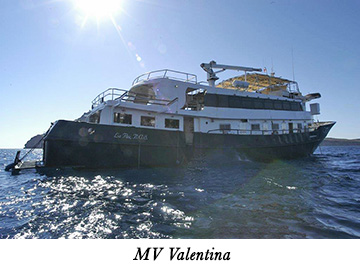 Upon boarding the vessel, Japanese divemaster Kengo Matsumoro greeted us with
a Japanese-accented English "hello" and a bow, which I replied to with another
bow. This made us immediate friends. Later, as Lorenzo Beltran, the dive operations
director, gave the welcome briefing, my eyes met Kengo's, and we recognized
each other, having met on previous trips to this area. He proved to be an
incredible divemaster who drew my attention to amazing macro opportunities all
week. Besides three divemasters, the vessel had two excellent chefs, a captain, an
engineer, and four crew for driving the inflatables (RIBs), schlepping gear and
pouring drinks. During the week, I was fascinated with the trilingual conversations:
Lorenzo and others conversing in Japanese with Kengo; American customers
trying rudimentary Spanish; the Mexican crew speaking excellent English to none at
all. Actually, the result was surprisingly good communication and superb customer
service.
Upon boarding the vessel, Japanese divemaster Kengo Matsumoro greeted us with
a Japanese-accented English "hello" and a bow, which I replied to with another
bow. This made us immediate friends. Later, as Lorenzo Beltran, the dive operations
director, gave the welcome briefing, my eyes met Kengo's, and we recognized
each other, having met on previous trips to this area. He proved to be an
incredible divemaster who drew my attention to amazing macro opportunities all
week. Besides three divemasters, the vessel had two excellent chefs, a captain, an
engineer, and four crew for driving the inflatables (RIBs), schlepping gear and
pouring drinks. During the week, I was fascinated with the trilingual conversations:
Lorenzo and others conversing in Japanese with Kengo; American customers
trying rudimentary Spanish; the Mexican crew speaking excellent English to none at
all. Actually, the result was surprisingly good communication and superb customer
service.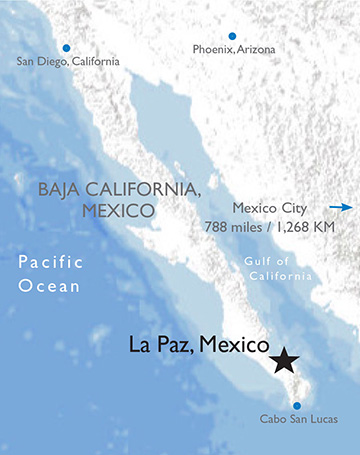 I might note that Mexicans call sea
lions lobos del mar or sea wolves, a far more
accurate description than "lions." Look at
them head on, and they appear canine; their
manners, social communities or colonies are
like wolves, their hunting techniques are
like wolves, and their "roar" is a canine
bark.
I might note that Mexicans call sea
lions lobos del mar or sea wolves, a far more
accurate description than "lions." Look at
them head on, and they appear canine; their
manners, social communities or colonies are
like wolves, their hunting techniques are
like wolves, and their "roar" is a canine
bark. 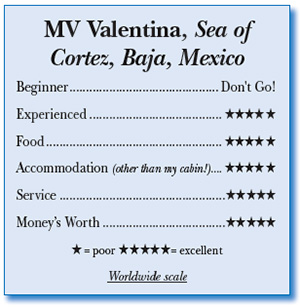 Doors to the 10 staterooms line the
walkway on both sides of the vessel. It's
a couple of steps down into each cabin,
which vary in size and configuration. Each
has a separate sink along with a wardrobe,
a dresser, two beds and spacious shower
separate from the head. Each morning, the
crew changed the sheets while divers were
underwater. Should you go, avoid the front
two cabins, numbers 1 and 6. Their elevated
front bunks are poised above the anchor chain locker . When the anchor is lowered
in the early morning, the chain links fly out of the locker, causing those bunks
to bounce like a trampoline. I know. One of these was my bunk. Quite an alarm
clock.
Doors to the 10 staterooms line the
walkway on both sides of the vessel. It's
a couple of steps down into each cabin,
which vary in size and configuration. Each
has a separate sink along with a wardrobe,
a dresser, two beds and spacious shower
separate from the head. Each morning, the
crew changed the sheets while divers were
underwater. Should you go, avoid the front
two cabins, numbers 1 and 6. Their elevated
front bunks are poised above the anchor chain locker . When the anchor is lowered
in the early morning, the chain links fly out of the locker, causing those bunks
to bounce like a trampoline. I know. One of these was my bunk. Quite an alarm
clock.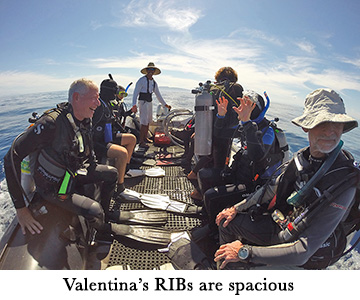 Perhaps my most unusual dive of the week was the mobula ray night dive. A
few years ago, the crew discovered that when anchored at night in a certain shallow
bay, the ship's lights attracted clouds of krill, which in turn attracted
fleets of mobula rays, which are nocturnal krill feeders. Hence, this easy dive
was born, requiring divers to kneel on the sandy bottom at 30 feet, surrounded by
hordes of mobulas zipping around, and at times even colliding with the divers. It
reminded me of the classic Kona, Hawaii, manta dive, but with a hundred minimantas
just 18 inches across swirling around. And, there was more excitement. An
octopus crawled up my buddy's leg while he was kneeling on the sand.
Perhaps my most unusual dive of the week was the mobula ray night dive. A
few years ago, the crew discovered that when anchored at night in a certain shallow
bay, the ship's lights attracted clouds of krill, which in turn attracted
fleets of mobula rays, which are nocturnal krill feeders. Hence, this easy dive
was born, requiring divers to kneel on the sandy bottom at 30 feet, surrounded by
hordes of mobulas zipping around, and at times even colliding with the divers. It
reminded me of the classic Kona, Hawaii, manta dive, but with a hundred minimantas
just 18 inches across swirling around. And, there was more excitement. An
octopus crawled up my buddy's leg while he was kneeling on the sand.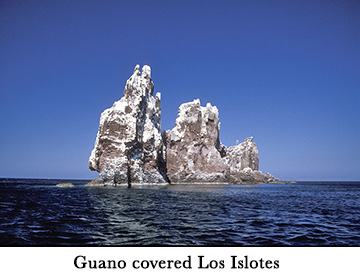 One odd aspect of a trip aboard the Valentina is that we were required
to overnight in a La Paz hotel both the night of arrival and the night before
departure (noncharter customers only stay in a hotel after disembarking). Lorenzo explained that Mexico does not want us to fly in, get on a boat owned by
a non-Mexican company, and then depart without leaving dollars in Mexico. So the
first night, we stayed at the upscale Costa Baja, in a marina surrounded by several
excellent restaurants on the eastern edge of town. At night, locals and tourists
by the hundreds flocked to the nearby nightclubs. The night before departure,
we were put up at the Hyatt. Several of us explored the streets, others partied
until dawn, but my roommate and I just watched the beautiful sunset over the bay
and crashed.
One odd aspect of a trip aboard the Valentina is that we were required
to overnight in a La Paz hotel both the night of arrival and the night before
departure (noncharter customers only stay in a hotel after disembarking). Lorenzo explained that Mexico does not want us to fly in, get on a boat owned by
a non-Mexican company, and then depart without leaving dollars in Mexico. So the
first night, we stayed at the upscale Costa Baja, in a marina surrounded by several
excellent restaurants on the eastern edge of town. At night, locals and tourists
by the hundreds flocked to the nearby nightclubs. The night before departure,
we were put up at the Hyatt. Several of us explored the streets, others partied
until dawn, but my roommate and I just watched the beautiful sunset over the bay
and crashed.  Diver's Compass: The standard six day/five night rate is $2495; out group rate of roughly $2800 added a day and two hotel stays
... Nitrox 32 was $120 for six days (22 dives) ... In La Paz, be
careful what you ingest unless your G.I. tract is used to the
difference. But no one in the group had any problems, even those
who ate delicious tacos from the wonderful sidewalk taco stands
... For more authentic Mexican food, try the Aura restaurant and
Hotels 7 Crown, which is near Valentina's pier ... The Fun Azul
also makes trips to the Socorro Islands of the Pacific Coast of
Mexico
Diver's Compass: The standard six day/five night rate is $2495; out group rate of roughly $2800 added a day and two hotel stays
... Nitrox 32 was $120 for six days (22 dives) ... In La Paz, be
careful what you ingest unless your G.I. tract is used to the
difference. But no one in the group had any problems, even those
who ate delicious tacos from the wonderful sidewalk taco stands
... For more authentic Mexican food, try the Aura restaurant and
Hotels 7 Crown, which is near Valentina's pier ... The Fun Azul
also makes trips to the Socorro Islands of the Pacific Coast of
Mexico 